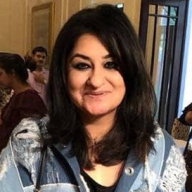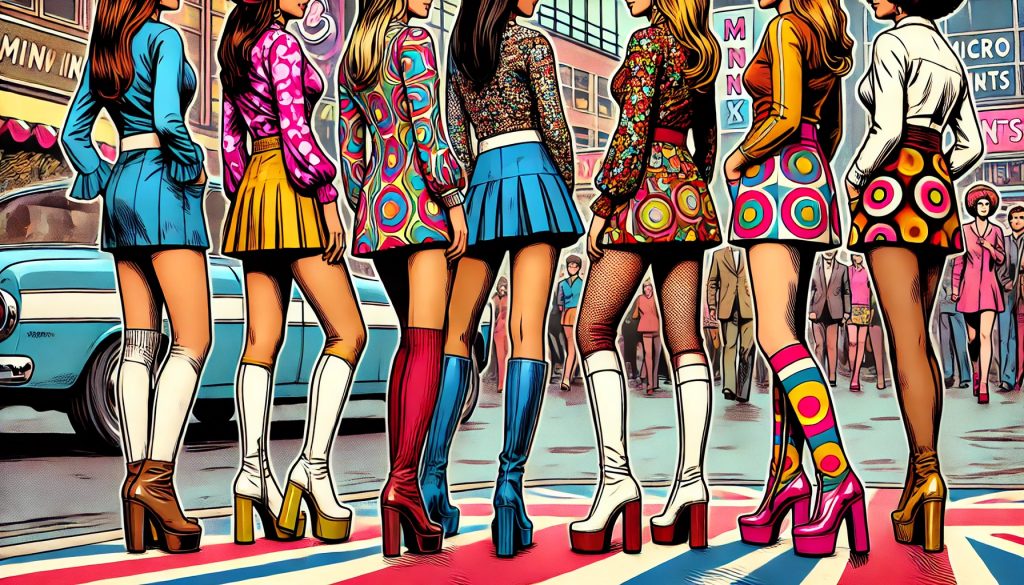The 1960s fashion trends were the signature of individual expression. The rise of counterculture, the fight for civil rights, Neil Armstrong’s first step onto the moon, and the Kennedy assassination were some of the major events that influenced the 60s fashion trends. Let us find out more.

‘60s fashion trends became a powerful mirror of a society in flux
Fueled by growing economic prosperity and a yearning to break away from convention, ‘60s fashion trends became a powerful mirror of a society in flux. Bold, daring, and unapologetically unique, the era’s trends captured the spirit of a generation redefining what it meant to be modern and liberated. The 1960s allowed women to establish a sense of identity and play with their looks so it doesn’t come as a surprise that this era of experimentation is experiencing a renaissance in 2024.
Hemlines rose, patterns swirled, and silhouettes sharpened, reflecting the era’s individuality and rebellion against tradition. However, fashion wasn’t just about looking good; it was about making a statement. Each trend reflected the changing times, whether it was the mini skirt that hinted at sexual liberation or the bold psychedelic prints that captured the spirit of a time defined by youthful energy, experimentation, and a relentless push for change.
Fashion in the 1960s wasn’t merely about what people wore—it was about who they were and the world they envisioned. This era went down in fashion history with top designers including Yves Saint Laurent, Balenciaga, André Courrèges, Paco Rabanne, Mary Quant, Pierre Balmain, Hubert de Givenchy, Emilio Pucci, and Pierre Cardin, at the forefront.
Iconic 60s Fashion Trends
The Mini Skirt
The mini skirt was more than just a fashion trend in the 1960s—it was a cultural statement. Popularised by British designer Mary Quant, this daring piece of clothing represented the youthful rebellion and freedom of the decade. Women embraced the mini skirt as a way to break away from traditional, conservative attire, favouring shorter hemlines that showcased their legs and confidence. The mini skirt became synonymous with the “Swinging London” scene and was often paired with knee-high boots and bold, geometric patterns that further amplified its modern appeal.
Per Vogue: ‘So did Mary Quant invent the miniskirt as is often said? It’s not as straightforward as a simple yes. But it was a lace dress from the designer in 1964 and Quant’s accessible price points that really caught on; her lower-cost label dubbed Mary Quant’s Ginger Group really helped fuel the short-skirt craze among the youth. Regardless, it took a couple of years before the style, which first just skimmed the flesh above the knee, was widely adopted. By the end of the decade, it was acceptable for styles to reach micro-mini levels. So much leg was on display that sheer stockings had to be swapped for tights!’
This iconic trend not only redefined women’s fashion but also had a significant social impact, symbolising a shift in gender norms and expectations. It was embraced by celebrities like Twiggy and Brigitte Bardot, who showcased it in fashion magazines and on runways, cementing its status as a global phenomenon. The mini skirt’s popularity spread rapidly, influencing fashion across continents and cementing its place as a quintessential symbol of 1960s style and attitude.
Psychedelic Prints and Patterns
The 1960s were a time of experimentation and change, and nowhere was this more evident than in the vibrant, psychedelic prints and patterns that took over the fashion world. Influenced by the counterculture movement and the rise of psychedelic music and art, these bold designs featured swirling shapes, vivid colours, and intricate details that often appeared almost hypnotic. Designers like Emilio Pucci led the charge, creating garments that were visually striking and impossible to ignore.
These prints were not just about making a fashion statement; they were an expression of the era’s spirit of liberation and exploration. Worn on everything from dresses and skirts to accessories and home decor, psychedelic patterns became a visual representation of the era’s emphasis on breaking boundaries and embracing new ideas. Whether in bright, clashing colours or more subdued, earthy tones, these patterns brought a sense of playful chaos to fashion, reflecting the dynamic and transformative nature of the 1960s.
The Mod Look

The Mod look was characterised by clean lines, bold colours and geometric shapes.
The Mod look, characterised by its clean lines, bold colours, and geometric shapes, became a defining style of the early 1960s. Emerging from London’s youth culture, the Mod trend was a sharp departure from the more conservative styles of previous decades. It was marked by A-line mini dresses, colour-blocking, and the widespread use of black and white. Designers like André Courrèges and Mary Quant were instrumental in popularising this style, which celebrated a sleek, futuristic aesthetic that felt fresh and revolutionary.
The Mod trend wasn’t just about clothing—it was a complete lifestyle, influencing everything from hairstyles to music. Mods were known for their sharp dressing, often donning tailored suits, skinny ties, and Chelsea boots. The look was sophisticated yet youthful, reflecting the optimism and forward-thinking spirit of the time. This trend also embraced unisex fashion, with women and men often sharing similar styles, a progressive shift that further emphasised the breaking down of traditional gender norms.
The Hippie Movement and Bohemian Style
The hippie movement of the 1960s was a powerful cultural force that not only influenced societal norms but also left an indelible mark on fashion. In 1967, thousands of free-spirited individuals gathered in San Francisco’s Haight-Ashbury district for what became known as the Summer of Love—a vibrant convergence of music, art, and ideals of peace and self-expression. Two years later, the iconic Woodstock Festival in New York solidified the movement, drawing hundreds of thousands to celebrate peace, love, and freedom. These gatherings weren’t just musical milestones; they were a visual showcase of the hippie aesthetic that would go on to define the era.
Fashion during this period embraced the free-spirited ethos of the counterculture movement, featuring bohemian maxi dresses adorned with ditsy florals, flowing and relaxed silhouettes. Long, flowing skirts, bell-bottom jeans, and peasant blouses became staples of this trend, along with ethnic-inspired accessories like beaded necklaces, fringe bags, and headbands.
The use of natural materials and tie-dye patterns was widespread, reflecting a desire to connect with nature and reject the commercialism of mainstream fashion. The hippie look was more than just a style—it was a visual manifesto of the era’s desire for social and political change, making it one of the most enduring legacies of 1960s fashion. The enduring legacy of hippie fashion lies in its ability to challenge the boundaries of style, creating a lasting influence that continues to inspire contemporary fashion today.
Space-Age Fashion

The Space Race of the 1960s captivated the world’s attention
The Space Race of the 1960s not only captivated the world’s attention but also influenced the fashion industry, leading to the emergence of space-age fashion. Fashion designers like Pierre Cardin, André Courrèges and Emanuel Ungaro pioneered this trend. The space-age style was characterised by minimalistic design, structured silhouettes, and a palette of white, silver, and other metallics.
Per Vogue: ‘The era’s fascination with space exploration was expressed in a new style movement called Atomic and, in the fashion world, a crop of designers let their fancies take flight: André Courrèges, Paco Rabanne, and Pierre Cardin. Gleaming aluminium foil-esque silver vinyl decorated a collection of PVC moon girl fashions for “Courrèges’ Spring/Summer 1964 ‘Space Age’ collection, which also featured ‘astronaut’ hats and goggles and mid-calf-length boots”. In 1966, Cardin released a collection of pinafore dresses that were worn over slinky knots and turtlenecks.’
This trend extended beyond clothing to accessories, with oversized sunglasses, helmet-like hats, and go-go boots becoming emblematic of the style. Space-age fashion represented a break from traditional aesthetics, embracing a vision of fashion that was bold, experimental, and ahead of its time. It embodied the excitement and curiosity of an era looking to the stars, pushing the boundaries of what fashion could be and how it could reflect the spirit of the times.
Celebrities who influenced 1960s fashion trends
The 1960s was a revolutionary decade for fashion, significantly shaped by the influential styles of celebrities who embodied the era’s spirit of liberation and change. Icons like Audrey Hepburn and Twiggy set new standards of elegance and modernity. Audrey Hepburn’s sophisticated, minimalist style, characterised by her iconic little black dress in Breakfast at Tiffany’s popularised the concept of chic simplicity. Her influence extended beyond film, as women across the globe embraced her polished yet effortless look, favouring sleek lines and monochromatic colour palettes. In contrast, Twiggy, the British model who became the face of the Mod movement, introduced a playful, youthful energy to fashion with her boyish pixie haircut, bold eyeliner, and vibrant, geometric mini dresses. Her androgynous aesthetic and preference for bold patterns and colours challenged traditional feminine ideals, making her a symbol of the decade’s progressive attitude.
Another pivotal influence on 1960s fashion came from music and pop culture, with stars like The Beatles and Jackie Kennedy reshaping public perceptions of style. The Beatles’ evolution from clean-cut suits to psychedelic attire mirrored the changing landscape of the decade, as they embraced vibrant colours, floral prints, and eclectic accessories, which inspired the “Summer of Love” aesthetic. Meanwhile, Jackie Kennedy’s timeless, sophisticated fashion choices, such as her pillbox hats and elegant A-line dresses, set a standard for refined, polished style that contrasted sharply with the youth-driven trends of the time. Her poised, classic look became a symbol of grace and elegance, influencing formal and professional wear for women across the world. Together, these celebrities not only defined the fashion trends of the 1960s but also reflected the broader cultural shifts of a transformative era.
FAQs: Reinterpreting 1960s Fashion Trends for Today
1.How can I incorporate the mini skirt into my modern wardrobe?
The mini skirt remains a versatile and stylish piece today. Pair it with a fitted turtleneck or an oversized sweater for a balanced silhouette. For a contemporary twist, try a leather or plaid mini skirt, and finish the look with ankle boots or sneakers for a chic yet casual vibe.
- How do I style psychedelic prints without looking outdated?
To modernise psychedelic prints, opt for pieces with subtle patterns and muted colours. Pair a psychedelic blouse with solid-coloured trousers or a monochrome skirt to keep the look grounded. Alternatively, use accessories like scarves or bags with these prints to add a pop of retro flair without overwhelming your outfit.
- Can I wear Mod fashion today without looking like I’m in costume?
Yes, you can embrace Mod style with sleek, tailored pieces like A-line dresses or structured blazers. Stick to a minimalist colour palette with bold accents, such as a black-and-white dress paired with coloured tights or geometric jewellery. Keep the rest of your look modern with contemporary footwear and accessories.
- How do I integrate bohemian and hippie styles into a sophisticated look?
To create a refined bohemian aesthetic, choose flowing silhouettes in rich fabrics like silk or linen. Opt for neutral tones or earthy colours, and accessorise with statement pieces like layered necklaces or fringe details. You can also blend bohemian prints with structured pieces, such as a paisley blouse tucked into tailored trousers.
- What’s a modern way to wear 1960s space-age fashion?
Embrace the futuristic elements of space-age fashion by incorporating metallics and sleek, minimal designs into your outfits. Look for pieces with clean lines and innovative materials like a metallic skirt or a PVC jacket. Pair these statement pieces with neutral basics to keep the look modern and wearable.
- How can I wear go-go boots without looking too retro?
Go-go boots can be seamlessly incorporated into modern outfits by choosing pairs in neutral colours like black or white. Pair them with a midi skirt or cropped trousers to balance the boldness of the boots. Avoid overly patterned or flashy clothing to keep the look contemporary.
- Are 1960s accessories still fashionable today?
Yes, 1960s accessories like oversized sunglasses, headbands, and statement jewellery can still elevate modern outfits. To avoid a costume-like appearance, use these accessories sparingly. For example, pair oversized sunglasses with a sleek, minimalist outfit or use a bold headband to add interest to a simple dress.
- How do I incorporate 1960s-inspired bold patterns into my daily wear?
To make bold patterns work for everyday wear, choose one statement piece, such as a geometric-print blouse or a chequered skirt, and keep the rest of your outfit simple and neutral. This allows the pattern to stand out without overwhelming your look. Consider pairing bold patterns with classic pieces like denim or a black blazer.
- Can I wear 1960s-inspired bell-bottoms in a modern way?
Absolutely! Choose high-waisted bell-bottoms in a solid colour or subtle pattern, and pair them with a fitted top or blouse to balance the silhouette. Adding a modern jacket or blazer and contemporary accessories like minimalist jewellery can update the look and keep it from feeling too retro.
- How can I use 1960s fashion elements in professional attire?
Incorporate 1960s fashion into professional outfits by opting for structured, Mod-inspired pieces such as shift dresses or tailored blazers in classic colours. Pair these with contemporary elements like sleek heels or a modern handbag. You can also use bold prints sparingly—try a patterned blouse under a solid-coloured suit or a statement scarf to add a touch of vintage flair to your office look.
Conclusion
The cultural revolutions that emerged during the decade and how they each helped to redefine the modern woman, is reflected in the iconic 1960s fashion trends that helped shape fashion history. These fashion trends remain relevant today because they were more than just clothing choices—they represented a revolutionary shift in culture that still resonates.
The era’s emphasis on individuality, freedom of expression, and breaking away from convention continues to inspire fashion designers. The 1960s introduced groundbreaking styles like the mini skirt, psychedelic prints, and mod fashion, which challenged traditional norms and redefined the boundaries of fashion.
These trends not only set the stage for contemporary fashion but also serve as a timeless source of inspiration for modern interpretations, from the resurgence of bohemian aesthetics to the popularity of vintage-inspired looks. In a world that values self-expression and diversity, the spirit of the ’60s remains a powerful influence, reminding us that fashion can be a vehicle for social change and a celebration of personal style.
Read More:

Jasmeen Dugal is Associate Editor at FashionABC, contributing her insights on fashion, technology, and sustainability. She brings with herself more than two decades of editorial experience, working for national newspapers and luxury magazines in India.
Jasmeen Dugal has worked with exchange4media as a senior writer contributing articles on the country’s advertising and marketing movements, and then with Condenast India as Net Editor where she helmed Vogue India’s official website in terms of design, layout and daily content. Besides this, she is also an entrepreneur running her own luxury portal, Explosivefashion, which highlights the latest in luxury fashion and hospitality.











